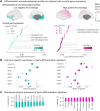Genetic foundations of interindividual neurophysiological variability
- PMID: 40700495
- PMCID: PMC12285703
- DOI: 10.1126/sciadv.ads7544
Genetic foundations of interindividual neurophysiological variability
Abstract
Neurophysiological brain activity shapes cognitive functions and individual traits. Here, we investigated the extent to which individual neurophysiological properties are genetically determined and how these adult traits align with cortical gene expression patterns across development. Using task-free magnetoencephalography in monozygotic and dizygotic twins, as well as unrelated individuals, we found that neurophysiological traits were significantly more similar between monozygotic twins, indicating a genetic influence, although individual-specific variability remained predominant. These heritable brain dynamics were mainly associated with genes involved in neurotransmission, expressed along a topographical gradient that mirrors psychological functions, including attention, planning, and emotional processes. Furthermore, the cortical expression patterns of genes associated with individual differentiation aligned most strongly with gene expression profiles observed during adulthood in previously published longitudinal datasets. These findings underscore a persistent genetic influence on neurophysiological activity, supporting individual cognitive and behavioral variability.
Figures




Update of
-
Genetic Foundations of Inter-individual Neurophysiological Variability.bioRxiv [Preprint]. 2025 Apr 29:2024.07.19.604292. doi: 10.1101/2024.07.19.604292. bioRxiv. 2025. Update in: Sci Adv. 2025 Jul 25;11(30):eads7544. doi: 10.1126/sciadv.ads7544. PMID: 39071281 Free PMC article. Updated. Preprint.
Similar articles
-
Genetic Foundations of Inter-individual Neurophysiological Variability.bioRxiv [Preprint]. 2025 Apr 29:2024.07.19.604292. doi: 10.1101/2024.07.19.604292. bioRxiv. 2025. Update in: Sci Adv. 2025 Jul 25;11(30):eads7544. doi: 10.1126/sciadv.ads7544. PMID: 39071281 Free PMC article. Updated. Preprint.
-
Prescription of Controlled Substances: Benefits and Risks.2025 Jul 6. In: StatPearls [Internet]. Treasure Island (FL): StatPearls Publishing; 2025 Jan–. 2025 Jul 6. In: StatPearls [Internet]. Treasure Island (FL): StatPearls Publishing; 2025 Jan–. PMID: 30726003 Free Books & Documents.
-
Genetic contributions to brain criticality and its relationship with human cognitive functions.Proc Natl Acad Sci U S A. 2025 Jul;122(26):e2417010122. doi: 10.1073/pnas.2417010122. Epub 2025 Jun 23. Proc Natl Acad Sci U S A. 2025. PMID: 40549906
-
Falls prevention interventions for community-dwelling older adults: systematic review and meta-analysis of benefits, harms, and patient values and preferences.Syst Rev. 2024 Nov 26;13(1):289. doi: 10.1186/s13643-024-02681-3. Syst Rev. 2024. PMID: 39593159 Free PMC article.
-
Drugs for preventing postoperative nausea and vomiting in adults after general anaesthesia: a network meta-analysis.Cochrane Database Syst Rev. 2020 Oct 19;10(10):CD012859. doi: 10.1002/14651858.CD012859.pub2. Cochrane Database Syst Rev. 2020. PMID: 33075160 Free PMC article.
References
-
- Kaufmann T., Alnæs D., Doan N. T., Brandt C. L., Andreassen O. A., Westlye L. T., Delayed stabilization and individualization in connectome development are related to psychiatric disorders. Nat. Neurosci. 20, 513–515 (2017). - PubMed
Publication types
MeSH terms
Grants and funding
LinkOut - more resources
Full Text Sources

